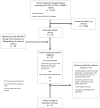Association between drug insurance cost sharing strategies and outcomes in patients with chronic diseases: a systematic review
- PMID: 24667163
- PMCID: PMC3965394
- DOI: 10.1371/journal.pone.0089168
Association between drug insurance cost sharing strategies and outcomes in patients with chronic diseases: a systematic review
Abstract
Background: Prescription drugs are used in people with hypertension, diabetes, and cardiovascular disease to manage their illness. Patient cost sharing strategies such as copayments and deductibles are often employed to lower expenditures for prescription drug insurance plans, but the impact on health outcomes in these patients is unclear.
Objective: To determine the association between drug insurance and patient cost sharing strategies on medication adherence, clinical and economic outcomes in those with chronic diseases (defined herein as diabetes, hypertension, hypercholesterolemia, coronary artery disease, and cerebrovascular disease).
Methods: Studies were included if they examined various cost sharing strategies including copayments, coinsurance, fixed copayments, deductibles and maximum out-of-pocket expenditures. Value-based insurance design and reference based pricing studies were excluded. Two reviewers independently identified original intervention studies (randomized controlled trials, interrupted time series, and controlled before-after designs). MEDLINE, EMBASE, Cochrane Library, CINAHL, and relevant reference lists were searched until March 2013. Two reviewers independently assessed studies for inclusion, quality, and extracted data. Eleven studies, assessing the impact of seven policy changes, were included: 2 separate reports of one randomized controlled trial, 4 interrupted time series, and 5 controlled before-after studies.
Findings: Outcomes included medication adherence, clinical events (myocardial infarction, stroke, death), quality of life, healthcare utilization, or cost. The heterogeneity among the studies precluded meta-analysis. Few studies reported the impact of cost sharing strategies on mortality, clinical and economic outcomes. The association between patient copayments and medication adherence varied across studies, ranging from no difference to significantly lower adherence, depending on the amount of the copayment.
Conclusion: Lowering cost sharing in patients with chronic diseases may improve adherence, but the impact on clinical and economic outcomes is uncertain.
Conflict of interest statement
Figures





References
-
- Chobanian AV, Bakris GL, Black HR, Cushman WC, Green LA, et al. (2004) JNC 7 Express: the seventh report for the Joint Committee on prevention, detection, evaluation, and treatment of high blood pressure. In: Servics UDoHaH, editor: National Institutes of Health; National Heart, Lungh, and Blood Institute. pp. 1–66.
-
- Fihn SD, Gardin JM, Abrams J, Berra K, Blankenship JC, et al. (2012) 2012 ACCF/AHA/ACP/AATS/PCNA/SCA/STS guideline for the diagnosis and management of patietns with stable ischemic heart disease. JACC 60: e44–e164. - PubMed
-
- Grundy SM, Becker D, Clark LT, Cooper RS, Denke MA, et al. (2002) Third report of the National Cholesterol Education Program (NCEP) Expert Panel on the detection, evaluation and treatment of high blood cholesterol in adults (adult treatment panel III): final report. In: National Heart L, and Blood Institute editor: National Institute of Health. pp. 1–264.
Publication types
MeSH terms
LinkOut - more resources
Full Text Sources
Other Literature Sources
Medical

